Wildlife population in Namibia

In Namibia , located in southern Africa , around 17 percent of the country's area is under state nature protection. In addition, around 21 percent of the country's area is protected by numerous private initiatives, such as the so-called Conservancies . Since the mid-1960s, all wild animals have belonged to the owner of the land on which they live, since then the wild animal population in Namibia, especially on private, commercial farmland, has developed very positively. These are mainly antelopes , but also large African game such as giraffes , elephants , rhinos and predators .
The largest wildlife population is on commercial farmland and in the state and private conservation areas . The regions north of the Etosha National Park - with the exception of the Caprivi Strip - have a low wildlife population due to their communal use and high population density.
Counting and inventory
In state protected areas and large private nature reserves, a scientific animal count or survey is usually carried out every two to five years with the help of various statistical methods. As a rule, only larger wild animals or mammals are recorded.
For some animal species that enjoy special international protection, there are independent population figures for all of Namibia. This includes the elephant , whose population according to the IUCN (as of 2013) in Namibia is at least 16,054, possibly up to 25,018 animals. This represents an increase of more than 30 percent over 2007. The white rhino is loud CITES represented with 370 animals in Namibia, the black rhino with 1435 (2009). This means that Namibia has the largest free-living population of black rhinos in the world; With more than 3500 cheetahs it is also the largest population of this species. About 300 to 600 wild dogs are found in Namibia (as of 2014). The Namibia Crane Working Group has identified a population of a maximum of 19 paradise cranes ((as of May 2017); 60 in 2009), 19 clunker cranes (300 in 2009) and fewer than 5 South African crowned cranes (50 in 2009; 5 in 2013). The Namibia Nature Foundation (NNF) operates the system IRAS ( English for Information System for Rare Species Management ), which serves the management of rare animal species and, among other things, records their distribution.
For several years, Namibia, like South Africa for several years, has had to contend with increased poaching of rhinos. In 2015, 95 rhinos were poached, in 2016 60 and by mid-October 2017 27 rhinos.
In 2004 the Ministry of Environment and Tourism (MET) carried out a study on wildlife use in Namibia. This was the first time that the population of main game species was published for all of Namibia.
| photo | Animal species | Duration | Source / year |
|---|---|---|---|
 |
South African fur seal | 1.3 million | The Namibian (2012) |
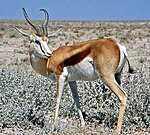 |
Kalahari springbok (see also springbok ) | 731,563 | MET (2004) |
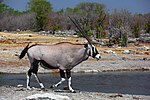 |
Gemsbok (Oryx, Gemsbock ) | 388.411 | MET (2004) |
 |
Zambezi greater kudu (see also Strepsiceros ) | 351,893 | MET (2004) |
 |
Warthog | 174.115 | MET (2004) |
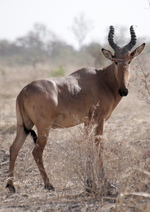 |
South African hartebeest (Hartebeest) | 125,088 | MET (2004) |
 |
Hartmann's mountain zebra | > 132,000 72,736 24,000 |
Red List (2016) MET (2004) Elly Hamunyela (2003) |
 |
African ostrich | 45,673 | MET (2004) |
 |
Eland (eland) | 37,216 | MET (2004) |
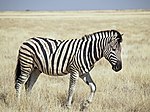 |
Burchell's plains zebra | 25,421 | MET (2004) |
 |
Blue wildebeest | 22,292 | MET (2004) |
 |
Black heel antelope | 15,442 | MET (2004) |
 |
Southern giraffe (see also giraffes ) | 10,415-15,000 |
MET (2004) & Giraffe Conservation Foundation (2015) |
 |
African elephant | 22000 9975-23000 |
MET (2018) MET (2004 & 2015) |
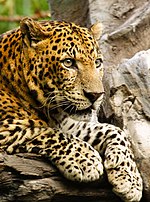 |
leopard | 11 733 14 154 8000 |
MET et al. (2019) Stein et al. (2011) MET (2004) |
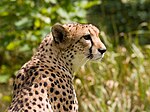 |
cheetah | 2500-3500 | MET (2004) & CCF (2011) |
 |
Elliptical waterbuck (waterbuck) | 3750-4475 | NNF (2010) & MET (2004) |
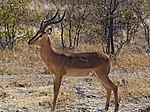 |
Black-nosed Impala | 3370 | MET (2004) |
 |
hippopotamus | 1387-1562 | NNF (2008) & MET (2004) |
 |
Cape buffalo | 1365-20000 | MET (2004) & NNF (2008) |
 |
Sable antelope | 1200-1233 | NNF (2008) & MET (2004) |
 |
Black rhinoceros | 1113-> 1500 | MET (2004) & MET (2009) & CITES (2009) |
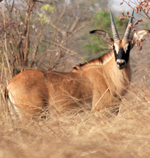 |
Roan antelope | 800-1090 | NNF (2008) & MET (2004) |
 |
lion | 660 1000–1600 1113–1644 (562–894) |
MET (2018) Africat (2015) MET (2012) (MET (2004) & DLC (2011)) |
 |
Letschwe | 400-534 | NNF (2008) & MET (2004) |
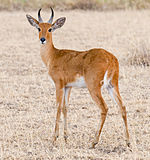 |
Grossriedbock | 200 | NNF (2008) |
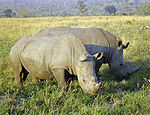 |
White rhinoceros | > 700 191-370 |
MET (2018) MET (2004) & CITES (2009) |
 |
Tsessebe (lyre antelope) | 177-350 | MET (2004) & NNF (2008) |
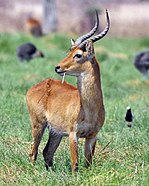 |
Puku | 50-1000 | NNF (2008) |
 |
Beach wolf (saddleback hyena) | 800-1200 | BHRP |
 |
Spotted hyena | 5000-8800 | BHRP |
 |
Nyala | 250 | IUCN |
| Waterfowl | 228,484 - 92 species | MET (2009) |
Selected wildlife counts
State territories
The following table gives an overview of the recorded populations of selected animal species in selected state protected areas and other state areas.
| area | buffalo | elephant | giraffe | Wildebeest | Impalas | Kudu | Oryx | Equine antelope |
Sable antelope |
jumping bock |
stone Böckchen |
ostrich | Zebras | was standing |
|---|---|---|---|---|---|---|---|---|---|---|---|---|---|---|
|
Etosha (22,275 km²) |
2611 | 3143 | 4244 | 5690 | 15550 | 3345 | 12982 2 802 1 |
2005 2012 |
||||||
|
Hardap (238 km²) |
48 | 444 | 1495 | 50 | - 1 | May 2019 | ||||||||
| Khaudum (North) | 2602 | 45 | 176 | 473 | 80 | 517 | 4 | 35 | 2015 | |||||
|
Zambezi region including Bwabwata National Park (6894 km²) |
3255-13,925 | 9570-27,470 | 399-749 | 1171-6249 | 3980-54,395 | 2605-8345 | 921-1581 | 1323-2608 | 668-1103 | 3445-5435 2 | August 2019 | |||
|
Waterberg Plateau Park (405 km²) |
1600 | May 2018 |
Communal Conservancies and Private Protected Areas
The table below gives an overview of the recorded populations of selected animal species in selected private protected areas and communal conservancies.
| area | buffalo | elephant | giraffe | Wildebeest | Impalas | Kudu | Oryx | Equine antelope |
Sable antelope |
jumping bock |
stone Böckchen |
ostrich | Zebras | was standing |
|---|---|---|---|---|---|---|---|---|---|---|---|---|---|---|
|
Kavango East (2 Conservancies) |
138-657 | 76-462 | 186-1501 | 343-1999 | 1495 | August 2019 | ||||||||
|
NamibRand nature reserve (1942 km²) |
6650 | 2944 | 144 | 440 2 | May 2016 | |||||||||
| Northwest including Kunene-Volkspark (69,000 km²) |
2035 | 6605 | 61,190 | 8220 | 8695 1 | May 2019 | ||||||||
| North Central (6564 km²) |
7 | 920 | 6075 | 2200 | 1240 | 790 2 | May 2019 | |||||||
| South (8000 km²) |
10–200 | 105-510 | 1650-8520 | 141-1260 | 150–1140 | May 2019 | ||||||||
|
Gondwana Canyon Park (1260 km²) |
829 | 2483 | 2421 | 319 | 331 | 934 1 110 2 |
June 2013 June 2015 |
|||||||
|
Gondwana Kalahari Park (100 km²) |
12 | 220 | 70 | 230 | 1100 | 100 | 70 2 | June 2018 | ||||||
| Nyae-Nyae & Nǂa-Jaqna | 250 | 1000 | 250 | 500 | 400 | 200 | 1500 | 200 | 2015 | |||||
| Doro! Nawas | 75 | 45 | 150 | 700 | 3800 | 100 | 180 | 700 1 | June 2001 |
1 Hartmann's zebra
2 Burchell's zebra
use
The wild animal population in Namibia is used commercially and in 2004 contributed around 700 million Namibian dollars to the gross domestic product . The Ministry of the Environment distinguishes between three different core areas:
- Use by tourists in the form of photo safaris, for example: N $ 434.29 million
- Hunting use: N $ 134.45 million
- Wildlife Trafficking Usage: N $ 70.05 million
Web links
- Ministry of Environment and Tourism (English)
- Environment Information Service Namibia (English)
- Namibia Nature Foundation (English)
- The Namibian Association of Community Based Natural Resource Management (CBNRM) Support Organizations (NACSO )
- Strengthening the Protected Area Network (English)
- Integrated Rural Development and Nature Conservation (English)
Individual evidence
- ↑ National Parks, Namibia Tourism Board ( Memento of the original from March 8, 2012 in the Internet Archive ) Info: The archive link was inserted automatically and has not yet been checked. Please check the original and archive link according to the instructions and then remove this notice. Retrieved April 28, 2011
- ^ Living with wildlife - the story of Namibia's Communal Conservancies. Namibian Association of CBNRM Support Organizations, 2011 (PDF; 2.2 MB)
- ↑ Trophy Hunting in Namibia from the 1960s to the Present Day, Marina Lamprecht, Hunters Namibia Safaris ( Memento of the original from September 15, 2013 in the Internet Archive ) Info: The archive link was inserted automatically and has not yet been checked. Please check the original and archive link according to the instructions and then remove this notice. Retrieved April 28, 2011
- ↑ The Economic Value of Namibia's Protected Area System: A Case for Increased Investment, Ministry of Environment and Tourism - Directorate of Parks & Wildlife Management, February 2010 ( Memento of the original from July 3, 2012 in the Internet Archive ) Info: The archive link became automatic used and not yet tested. Please check the original and archive link according to the instructions and then remove this notice. (PDF; 1.2 MB)
- ↑ State of Protected Areas in Namibia - A review of progress and challenges 2010, Ministry of Environment and Tourism, p. 72 ( Memento from September 4, 2015 in the Internet Archive ) (PDF; 7.6 MB)
- ↑ African Elephant Status Report 2013 - Namibia. , IUCN, 2013 ( page no longer available , search in web archives ) Info: The link was automatically marked as defective. Please check the link according to the instructions and then remove this notice. accessed on January 26, 2015
- ^ African and Asian Rhinoceroses - Status, Conservation and Trade, CITES, CoP15 Doc. 45.1 Annex - p. 2, November 20, 2009 ( Memento of the original from July 25, 2011 in the Internet Archive ) Info: The archive link was inserted automatically and has not yet been checked. Please check the original and archive link according to the instructions and then remove this notice. (PDF; 296 kB)
- ^ Conservancy Tourism, Namibia Tourism Board.Retrieved April 28, 2011
- ^ The Problem. Cheetah Conservation Fund accessed April 30, 2011
- ↑ NAMIBIA'S AFRICAN WILD DOG CONSERVATION PROGRAM. Naankuse, accessed January 26, 2015 in 2014
- ↑ Blue Cranes face extinction in Namibia. The Namibian, May 10, 2013, p. 8
- ↑ Crane Species of Namibia, Namibia Crane Working Group (PDF; 258 kB) accessed on May 2, 2011
- ↑ IRAS. NNF accessed January 16, 2014
- ↑ October 23, 2017 - News in the evening. Hitradio Namibia, October 23, 2017.
- ↑ Wildlife resource accounts for Namibia, 2004. Ministry of Environment and Tourism, In: DEA RESEARCH DISCUSSION PAPER, June 2009, No. 79
- ↑ Annual Namibia seal cull to start amid protests. The Namibian, July 16, 2012 ( memento of February 21, 2013 in the web archive archive.today ) accessed on July 16, 2012
- ↑ Equus zebra hartmannae. The Red List of Mammals of South Africa, Lesotho and Swaziland, 2016. Retrieved February 10, 2020.
- ↑ Elephant Booklet, Namibia Nature Foundation, May 2008, p. 6 ( Memento of the original from November 15, 2011 in the Internet Archive ) Info: The archive link has been inserted automatically and has not yet been checked. Please check the original and archive link according to the instructions and then remove this notice. ( ZIP ; 12.4 MB)
- ↑ a b c d Reedbuck, waterbuck, red lechwe and puku Booklet, Namibia Nature Foundation, May 2008 ( Memento of the original from November 15, 2011 in the Internet Archive ) Info: The archive link was inserted automatically and has not yet been checked. Please check the original and archive link according to the instructions and then remove this notice. ( ZIP ; 13.8 MB)
- ↑ Hippopotamus Booklet, Namibia Nature Foundation, May 2008, p. 6 ( Memento of the original from November 15, 2011 in the Internet Archive ) Info: The archive link has been inserted automatically and has not yet been checked. Please check the original and archive link according to the instructions and then remove this notice. ( ZIP ; 10.4 MB)
- ↑ Buffalo Booklet, Namibia Nature Foundation, May 2008, p. 4 ( Memento of the original from November 15, 2011 in the Internet Archive ) Info: The archive link has been inserted automatically and has not yet been checked. Please check the original and archive link according to the instructions and then remove this notice.
- ↑ a b c Roan, sable and tsessebe Booklet, Namibia Nature Foundation, May 2008, p. 6 ( Memento of the original from November 15, 2011 in the Internet Archive ) Info: The archive link has been inserted automatically and has not yet been checked. Please check the original and archive link according to the instructions and then remove this notice. ( ZIP ; 12.5 MB)
- ↑ a b Annual Report 2009/10, Ministry of Environment and Tourism, p. 12 ff ( page no longer available , search in web archives ) Info: The link was automatically marked as defective. Please check the link according to the instructions and then remove this notice.
- ↑ World Lion Day 2018, MET, August 10, 2018.
- ↑ 08/10/2015 News at noon. Hitradio Namibia, August 10, 2014 ( page no longer available , search in web archives ) Info: The link was automatically marked as defective. Please check the link according to the instructions and then remove this notice.
- ^ Large Carnivore Atlas 2012. In: Ministry of Environment & Tourism, Namibia
- ↑ The Namibian Lion Population, Deser Lion Conservation ( Memento of the original from March 4, 2011 in the Internet Archive ) Info: The archive link was inserted automatically and has not yet been checked. Please check the original and archive link according to the instructions and then remove this notice. Retrieved April 30, 2011
- ^ The Brown Hyena (Parahyaena brunnea) in Namibia. Brown Hyena Research Project ( Memento of the original from January 8, 2014 in the Internet Archive ) Info: The archive link was inserted automatically and has not yet been checked. Please check the original and archive link according to the instructions and then remove this notice. Retrieved January 5, 2014
- ↑ The Spotted Hyena (Crocuta crocuta) in Namibia. Brown Hyena Research Project ( Memento of the original from August 8, 2013 in the Internet Archive ) Info: The archive link was automatically inserted and has not yet been checked. Please check the original and archive link according to the instructions and then remove this notice. Retrieved January 5, 2014
- ↑ Tragelaphus angasii. IUCN, accessed January 5, 2014 in 1999
- ↑ State of Protected Areas in Namibia - A review of progress and challenges, MET, 2010 ( Memento from September 4, 2015 in the Internet Archive ) (PDF; 7.6 MB)
- ^ Mountain Zebra Project. NNF, 2012.
- ↑ Hardap Game Count. NACSO, May 2019.
- ↑ Game Counts: Khaudum North Complex. NACSO, 2015. Retrieved February 5, 2016
- ↑ NACSO, August 2019.
- ↑ Game Counts in Bwabwata NP. NACSO, August 2019.
- ^ Buffalo population at Waterberg concerns farmers. Namibia Press Agency, May 15, 2018.
- ^ Kavango East Game Count. NACSO, August 2019.
- ↑ The Barking Gecko. NamibRand Nature Reserve, August 2016, p. 4
- ^ North West Game Count. NACSO, May 2019.
- ↑ Game Counts in North Central Namibia. NACSO, May 2019.
- ↑ Game Counts in Southern Namibia. NACSO, May 2019
- ↑ Gondwana Cañon Park Game Count 2013. Gondwana Collection, September 2013 ( Memento of the original from October 21, 2013 in the Internet Archive ) Info: The archive link was inserted automatically and has not yet been checked. Please check the original and archive link according to the instructions and then remove this notice. (PDF; 954 kB) accessed on October 17, 2013
- ↑ Game count results by year. The Greater Fish River Canyon Landscape. Retrieved February 17, 2020.
- ↑ Taking stock of wildlife at Gondwana Kalahari Park. Gondwana Collection, June 2018.
- ^ Full Moon Waterhole County in Nyae-Nyae and Nǂa-Jaqna NACSO, 2015. Retrieved February 5, 2016
- ^ Executive Summary - Annual Game Census for DORO! NAWAS , June 2001, Doro! Nawas Conservancy
- ↑ Annual Report 2009/10, Ministry of Environment and Tourism, p. 8 ( page no longer available , search in web archives ) Info: The link was automatically marked as defective. Please check the link according to the instructions and then remove this notice.
- ↑ Game trade already in third place, Allgemeine Zeitung, June 21, 2011 ( Memento from December 31, 2015 in the Internet Archive )